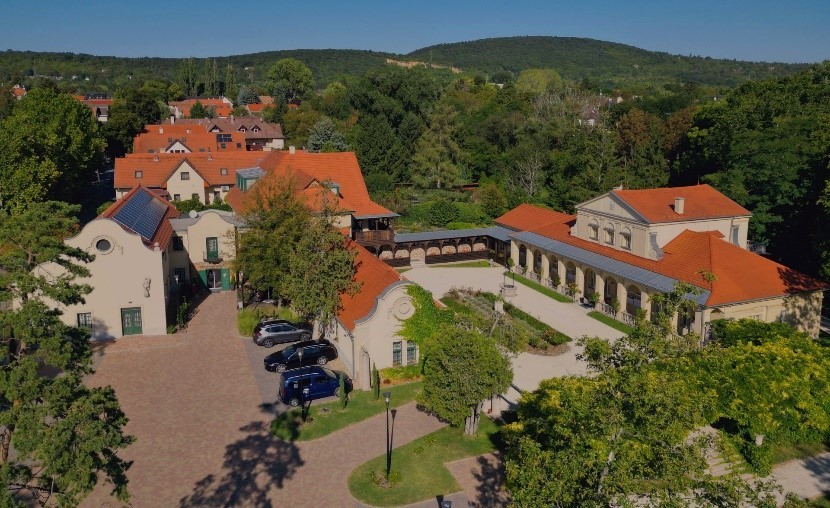Budapest
Emlékponttá nyilvánítás éve: 2025
A mai Klebelsberg-kastély története a 17. századig nyúlik vissza.
Ekkoriban egy földesúri udvarház és egy vendégház állt itt. A század végén Kurcz János Ignác báró, I. Lipót császári és királyi kamarása Hidegkút birtokosaként egy serfőzőházzal bővítette az itteni komplexumot. A báró az udvarházban ritkán járt, nagyrészt gazdatisztje lakott itt.
Kurcz halálát követően az épület Buda városához, majd a Magyar Királyi Kamarához került. Később a Terstyánszky és a Szunyogh család tagjai birtokolták a területet, azonban tartósan ők sem laktak itt. A birtok a 19. században került a Parsch család tulajdonába.
Gróf Klebelsberg Kuno a Budapest, Templom utca 12-14. sz. alatti épületegyüttest és az azt övező parkot 1922-ben vásárolta meg a Parsch családtól. A telken egy főépület (a mai kastélyépület) és több gazdasági melléképület állt, melyeket Klebelsberg átépített és új épületrésszel bővített. Az építkezés első üteme 1926-ban, a második üteme 1930-ban fejeződött be.
Az átépítést követően a belső udvarra a Templom utca felől egy népies épületszárny nézett, emeletén egy fából faragott erkéllyel; a kert felőli szárnyon pedig egy timpanonos, klasszicizáló-barokkos rizalitot alakítottak ki. Ez alatt eredetileg egy tornác volt az oszlopsor mögött.
Utóbbi épületrész kertre néző homlokzatának emeletén egy négy oszlopon nyugvó, erkélyes portikusz kapott helyet, a főbejáratot pedig a Klebelsberg család kovácsoltvas címere díszítette. Klebelsberg és felesége 1926-ban költözött be a kastélyba, de általában csak a nyarakat töltötték itt.
Klebelsberg Kuno 1932-ben bekövetkezett halála után a kastélyban özvegye és húga laktak. Az épületegyüttes egyes részeibe a helyi csendőrörs és a Pesthidegkúti Görgei Artúr cserkészcsapat költözött. A II. világháború után bérbe adták az épületet, és üdülőnek használták. 1949 februárjában az állam lefoglalta a kastélyt, decemberben pedig kitelepítette az özvegyet. Klebelsberg 4000 kötetes könyvtárát teherautóra dobálva, ismeretlen helyre vitték el.
1949 és 1954 között a Szakszervezetek Világszövetségének iskolája működött a kastélyban, majd 1958-ig SZOT üdülő, 1958 és 1970 között pedig a Pestmegyei Tanács Tüdőszanatóriuma. 1970 és 1978 között a Rókus kórház pszichiátriai és belgyógyászati részlege, 1978-tól a Semmelweis kórház pszichiátriai osztálya volt itt, egészen 1999-ig.
Az ezután lefolytatott privatizációs eljárást tulajdonjogi per akadályozta sokáig. 2008-ban került végül visszavásárlással ismét állami tulajdonba a kastély, a Magyar Nemzeti Vagyonkezelő Zrt. kezelésébe. Az épület 1999-től a felújítás megkezdéséig (2015-ig) lakatlan volt, a 16 év alatt az épületek műszaki állapota a vandál pusztítás, valamint az ázások következtében rendkívül leromlottá, romossá vált.
A Magyar Állam 2013 év végén különített el költségkeretet a kastély rekonstrukciójára.
Az engedélyezési és kiviteli tervek 2014 júniusában készültek el. A kivitelezésre nyílt közbeszerzési pályázat folyt le, amely 2015 szeptemberére zárult le és kezdődött el a kivitelezés.
2015 és 2017 között zajlott le a kastély rekonstrukciója. A kastély jelenlegi tulajdonosa a Polgári Művelődésért Oktatási, Kulturális és Tudományos Alapítvány, üzemeltetője a Pro Cultura Kft.
The history of the Klebelsberg Castle dates back to the 17th century.
A manor house and a guesthouse stood on the site at that time. At the end of the century, Baron János Ignác Kurcz, chamberlain to Emperor and King Leopold I as owner of the Hidegkút estate, expanded the complex by adding a brewery. The baron rarely visited the manor himself; his steward lived there.
After Kurcz’s death, the building belonged to the town of Buda and later to the the Royal Hungarian Chamber. Afterwards the Terstyánszky and Szunyogh families owned the property, although they did not reside there permanently either. In the 19th century, the estate passed into the ownership of the Parsch family.
Count Kuno Klebelsberg purchased the ensemble of buildings at Templom Street 12–14, along with the surrounding park, from the Parsch family in 1922. The site included a main building (the present-day castle) and several agricultural outbuildings, which Klebelsberg had rebuilt and expanded with a new wing. The first phase of the construction was completed in 1926, the second in 1930.
Following the reconstruction, a folk-style wing with a carved wooden balcony faced the inner courtyard from Templom Street, while the wing facing the garden was given a tympanum-topped, classicist-baroque-style projection. Originally a veranda with an open colonnade was behind.
On the garden facade of this wing, a portico with a balcony supported by four columns was built, and the main entrance was decorated with the coat of arms of the Klebelsberg family made of wrought - iron Klebelsberg and his wife moved into the castle in 1926, spending only the summer there.
After Kuno Klebelsberg’s death in 1932, his widow and his sister lived in the castle. Parts of the estate were used by the local gendarmerie post and the Arthur Görgei Scout Troop of Pesthidegkút. After World War II, the building was rented out and used as a holiday resort. In February 1949, the state seized the castle; in December the widow was evicted. Klebelsberg’s library of 4,000 volumes was thrown onto a truck and disappeared.
Between 1949 and 1954, the castle housed the school of the World Federation of Trade Unions. Then until 1958, it served as a holiday resort of the National Council of Trade Unions (SZOT), between 1958 and 1970 as the Pulmonary Sanatorium of the Pest County Council, from 1970 to 1978, it hosted the psychiatric and internal medicine departments of Rókus Hospital, and from 1978 until 1999 it functioned as the psychiatric ward of Semmelweis Clinic.
Subsequent privatization efforts were hindered for years by ownership disputes. In 2008, the castle was finally repurchased by the state and placed under the management of the Hungarian National Asset Management Inc. Between 1999 and 2015, the building stood vacant; during those sixteen years, its condition deteriorated severely due to vandalism and water damage.
At the end of 2013, the Hungarian State allocated funds for the castle’s restoration.
In June 2014 the permit and construction plans were completed, public procurement process for renovation followed, which concluded in September 2015, marking the start of the construction.
The restoration of the castle took place between 2015 and 2017. Today, the owner of the castle is the Foundation for Civic Education, Culture and Science, and it is operated by Pro Cultura Ltd.

